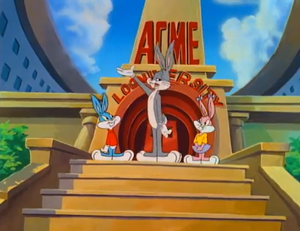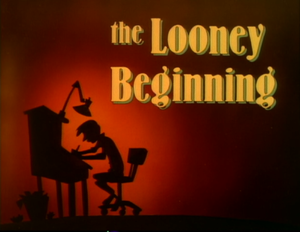The Looney Beginning
| The Looney Beginning | |
|---|---|
 | |
| Premiere date | September 14, 1990 |
| Run time | 23:09 |
| Starring | Charlie Adler Tress MacNeille Jeff Bergman Joe Alaskey Don Messick Frank Welker Cree Summer Danny Cooksey Maurice LaMarche |
| Music composed by | Mort Stevens |
| Writer(s) | Paul Dini Sherri Stoner |
| Storyboard artist(s) | Byron Vaughns Barry Caldwell |
| Director(s) | Glen Kennedy Dave Marshall Ken Boyer Rich Arons Andrea Romano (voices) |
| Episode navigation | |
| ← Previous | Next → |
| Title card | |

| |
"The Looney Beginning" is the first episode of Tiny Toon Adventures season one. It aired on September 14, 1990 on CBS. It was written by Paul Dini and Sherri Stoner, directed by Glen Kennedy, Dave Marshall, Ken Boyer, and Rich Arons, and voice directed by Andrea Romano.
In order to help the newly animated Buster and Babs defeat Montana and other would-be villains, Bugs Bunny creates a school for aspiring young comic entertainers of the next generation.
Detailed summary
Memorable quotes
Buster: A star is drawn!
Buster: Say, how about drawing me a best friend, a buddy, a compadre. Someone I can talk to, rabbit to rabbit.
(artist draws Babs)
Buster: A girl?!
Babs: Welcome to the nineties.
Bugs: Welcome to Acme Looniversity, institute of higher learning and lower comedy.
Characters
In order of appearance: | ||||||||||||||||||||||||||||||||||||||||||||||||||||||||||||||||||||||||||||
| ||||||||||||||||||||||||||||||||||||||||||||||||||||||||||||||||||||||||||||
Locations
- Earth
- United States
- California
- Los Angeles
- Hollywood
- The Hollywood Hotel
- Burbank
- Warner Bros. Studios lot
- Bug's residence
- Hollywood
- Los Angeles
- Acme Acres
- California
- United States
Objects
Vehicles
- None
Production
Development
Filming
It was copyrighted in 1990.
Music
The theme song was composed by Bruce Broughton, while the rest of the episode's music was composed by Mort Stevens.
Crew credits
- Storyboard artists: Byron Vaughns, Barry Caldwell
- Producer: Tom Ruegger
- Story editors: Paul Dini, Sherri Stoner
- Associate producer: Alfred Gimeno
- Casting director: Andrea Romano
- Timing director: Kennedy Animation
- Layout artists: Greg Reyna, Enrique May, Charles Visser, Garrett Ho
- Model designers: Tony Craig, Jeff Pidgeon, Alex McRae, Ken Boyer
- Key background designer: Dan McHugh
- Background layout artists: Stephen Lewis
- Background painter: Eric Radomski
- Post production supervisor: Joe Sandusky
- Show editors: Joe Gall, Al Breitenbach, Kelly Ann Foley
- Track reader: Henry Gilroy
- Voiceover assistant: Kelly Ann Foley
- Video supervisor: Jay Weinman
- Color key artist: Bunny Munns
- Model mark-up artist: Lisa Marie Leonardi
- Inkers and painters: Eric Nordberg, Lisa Marie Leonardi
- Main title animator: Tokyo Movie Shinsha Co.
- Music editor: Patricia Carlin for Triad Music
- Series character designers: Key Boyer, Alfred Gimeno
- Series background color stylist: Brian Sebern
- Negative cutter: Mary Duerrstein
- Laboratory services: CFI
- Animation checkers: Karl Jacobs, Brenda Brummett, Marina Cappas, Ana Durand, Paul B. Strickland
- Sound services: Thomas J. Maydeck
- Sound effects designer: Russell Brower
- Post production facilities: The Post Group, Soundcastle/PostModern
- Voice recording studio: B&B Sound, Jackson Schwartz, Warren Kleiman
- Production assistants: Debra Blanchard, Jeanne Barletta, Arlene Boyer, Priscilla Boyer, Steve Donmyer, Dawn Dunlop, Joey Franks, Rich Freeman, Glen Gagnon, Dave Guerrie, Kenneth Ross, Christopher Keenan, Michael McFerran, Randall McFerran, Marc Perry, Rich Pursel, Kirstyn Smithen, Victoria Stover, Robin Strickland, Cheryl Bartolotta
- Animation: Kennedy Cartoons
- Director: Glen Kennedy
- Animators: Willy Ashworth, Eui Sun Hwang, Sang-Jin Kim, Jon McClenahan, Darren Vanderberg, Sung Ku Won, Harold Duckett, E-Tae Kim, Mike Longden, Yeon Kun Noh, John Williamson, Alan Kennedy
- Animation services: Wang Film Productions Co.
- Supervisor: Dave Marshall
- Production administrator: Tim Sarnoff
- Amblin story editor: Doug Wood
- Production manager: Paul B. Strickland
- Executive in charge of production: Jean MacCurdy
- Production executives: Kathleen Kennedy, Frank Marshall
- Executive producer: Steven Spielberg
Release
Dates are in order of release:
- United States: September 8, 1990 at 8:30 pm on CBS
Behind the scenes
- Daffy's pitch of Honey, I Shrunk the Laundry is a reference to the 1989 film Honey, I Shrunk the Kids.
- When the cartoonist fights off the flames created by tough bunny, "Ride of the Valkyries" plays.
- The tough bunny is a parody of John Rambo from the 1980s Rambo film series.
- When the cartoonist paints Buster with green, orange, and pink, he quips, "Who are you? Ted Turner?" This line is a reference to the controversial decision made by Turner Entertainment to colorise several black and white movies Turner brought from MGM and RKO, including King Kong and shleved attempts to colorise Citizen Kane and Casablanca.
- Babs dresses up like country singer Dolly Parton.
- Babs dresses up as Jessica Rabbit from the 1988 film Who Framed Roger Rabbit. Then there is a more direct reference to Roger Rabbit after Buster says, "Roger, rabbit." Roger Rabbit was actually co-created by Steven Spielberg's Amblin and Disney, Warner Bros.' corporate rival.
- While wearing a pencil eraser on her head, Babs says, "La la la, I'm Eraserhead" in the voice of the character Pee Wee Herman.
- Babs question of "Is it a good voice or a bad voice?" refers to what Glinda the Good Witch asked in the 1939 movie The Wizard of Oz.
- Babs says she is 14 years old.
- Buster's original name for Acme Acres is Green Acres, a reference to the 1960s sitcom of the same name.
- Sweetie is three and a half minutes old.
- When Gogo says the line, "That is the question," from the play Macbeth, he is dressed as the Riddler from the 1960s Batman TV series.
- When Plucky is dressed like a superhero who can fly, he says, "Up, up and up some more," which is a paraphrase of "Up, up, and away," which is what was said by Superman in his 1940s radio series of the same name.
- When Gogo is temporarily thrown out of Acme Acres, he repeatedly says, "Redrum," which is "Murder" backwards and a reference to Stephen King's 1977 novel The Shining, and its 1980 film adaptation.
- Buster and Babs appear out of the logo at the end of the closing credits, dressing in flowery shirts and saying, "Aloha!"
- In reruns and certain online streaming sites, several scenes are cut:
- The animator drew a sombrero and tutu onto Buster.
- Sweetie and Furrball's auditions and their individual scenes after.
- Gogo appears at the end of Bugs's song to announce Buster and Babs don't have much time left.
- Buster's reiteration of Bugs's line that villains always fall for cheesy disguises before entering Montana's mansion.
- Buster and Babs escape from Montana's mansion is reminiscent of Indiana Jones's escape from the cave in the film 1981 film Raiders of the Lost Ark, directed by Steven Spielberg.
- Kath Souci isn't credited for voicing the two proto Busters.
Errors
- Buster's original name for Acme Acres is Green Acres, which is contradicted by the drawing already referring to it as the former.
- When the audition line is first seen, there are lookalikes of Little Beeper and Fifi.
- Hamton is first to be seen even though he wasn't first in line.
- Hamton, Sweetie, and Furrball are all standing back in the audition line again after they had already passed.
- Dizzy and Montana rush into Acme Acres after Babs says, "You're all in," despite both of them being immediately found by Buster in the villain box a couple of scenes later.
- Wile E. is in Calamity's grey colors.
- Kath Souci is credited for voicing Li'l Sneezer, even though he doesn't talk in this episode.
- Frank Welker isn't credited for voicing Furrball.
Everlasting influence
Critical reception
In other languages
| Language | Name | Meaning |
|---|---|---|
Home availability
- United States:
- July 29, 2008: Warner Home Video releases Tiny Toon Adventures: Season 1, Volume 1 on DVD.